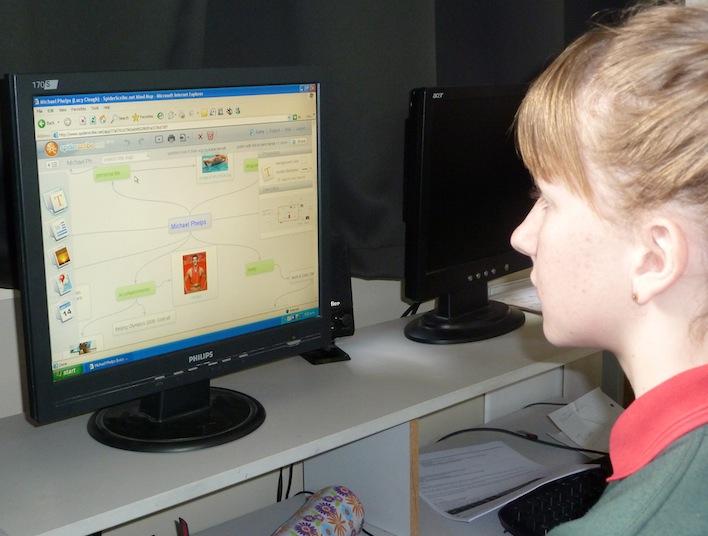Improving mindmapping skills for report writing with Spiderscribe
Tags: English | Interactive/thinking tools | Primary | Upper primary |
Year 8 students from Ashburton Intermediate use Spiderscribe, an online mindmapping tool, to plan and organise information for report writing.
Focusing the inquiry
In our school, we regularly inquire into the way higher order learning, enabled by digital technologies, meets learners’ needs.
eLPF 2014
The need
When students researched topics there was a tendency for them to copy/paste, change a few words, and believe they were writing "in their own words". Their work often showed chunks of information with vocabulary and phrasing that were not typical of other work they produced.
The class had begun a new unit that involved researching a sportsperson in order to write a report. Students selected a person to research and were copying key information from online biographies and websites into a Word document. Their next step was to use a highlighter and make notes from this to use for their writing; a tedious process of double handling information.
The teacher wanted a simple way for these year 8 students to take notes digitally in a quick and efficient manner and then use this information to write a report.
Choosing an online mindmapping tool
After exploring a couple of different options for taking notes digitally, the teacher selected Spiderscribe , an online mind mapping and brainstorming tool, because it seemed user-friendly, and would allow students to:
- create mindmaps
- add text, images, documents, maps, and dates to their mindmaps
- group information readily
- add information from more than one source
- move or add information over time
- customise individual items within their mindmaps.
The teacher spent some time exploring Spiderscribe's features before introducing the tool to her students.
Teaching and learning
Using Spiderscribe for notetaking while researching
With the introduction of Spiderscribe, students worked directly from the website/s they were using for their research. They did their reading online and put notes onto their Spiderscribe mindmap, which they had opened on another tab. They created boxes for each piece of information they gathered.
Re-organising mindmaps
As the students neared the completion of their mindmaps, they were asked to re-organise their information according to the paragraphs they intended to write. The flexibility of moving text boxes to group ideas together digitally meant students could try different ways of organising their information easily.
When they were satisfied with the way they had arranged their mindmaps, the students printed them off and used this to refer to when writing their assessment task.
Learning inquiry assessment task
The assessment task was a hand-written biography in the format of a report (previously taught in class). It was completed in class with their only reference being their mindmap and personal knowledge about the sportsperson.
Prior to Spiderscribe being introduced, students had begun to complete a report plan template with their gathered information. Some used this template to organise their information report alongside their computer-generated mindmaps.
The information reports students produced were well-ordered with information correctly paragraphed and generally in students' own words. Most of the students wrote a report that met asTTle Level 4. Students were more confident undertaking the assessment with the mindmaps as a point of reference and that the organisation process they went through helped to improve their information literacy skills.
Reflections
Teacher reflection
Once the students were shown how to use Spiderscribe, most of them immediately switched to using it.
While the format of the information report still needed explicit teaching, the ability to label and move grouped information around within the SpiderScribe mindmap as they researched was a significant advantage.
In the future students would not be expected to copy and paste text from Internet sites into a Word document before starting to work on their mindmap. This proved to be an unnecessary step as it was double-handling information and the students naturally moved away from doing this as they began to see the benefits of using the online mindmaps.
The appeal of using an online tool was motivating for students, and they seemed to have more information organised in a shorter time. Printing out their mindmaps and using them for reference gave students the confidence to write as their ideas and information were sorted into a structure.
Student reflections
Students comment on:
- Spiderscribe mindmaps as a tool for writing
- what impact they thought it had had on their learning.
"Spiderscribe is very useful to use and you can easily organise topics into sub-topics."
"I found the programme very very helpful; instead of having my planning spread out on a word document, it makes it succinct and it's easier to write your biography."
"Spiderscribe is very useful to use and it helped lots with note-taking. I had more than enough information to write a biography."
"Very fun with a new experience and it was easy to write a biography on the notes."
"This was useful for note-taking and helpful for recording information."
Next steps
"I can already see another application for this tool for improving writing outcomes in imaginative writing. Students could use a mindmap to map out the key events of their story. This could help them focus them on the structure of narratives and provide a useful scaffold during the writing process."
– Teacher
